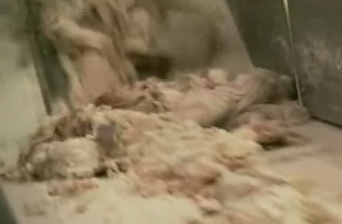Pink slime still available
"Fat, sinew, bloody effluvia, and bits of meat." Oh, and ammonia"
 Since beef is an important ingredient for most bodybuilding diets and even a lotta fastfood is consumed on the "Junk Day". we want to inform you about the quality like we did before: //juicedmuscle.com/jmblog/content/happy-fastfood-menu?page=1
Since beef is an important ingredient for most bodybuilding diets and even a lotta fastfood is consumed on the "Junk Day". we want to inform you about the quality like we did before: //juicedmuscle.com/jmblog/content/happy-fastfood-menu?page=1
This is what you're eating when you buy and prepare ground beef from most grocery stores in the U.S. today. It's also what you're eating when you eat a fast food burger or grab a quick bite at your local diner, most likely.
The latest issue of Mary Jane's Farm spreads some light on what's really in our ground beef. And the results of what they found are enough to make this particular blogger swear off ground beef for good. The article isn't online yet, but here are a few choice quotes:
- "Ten years ago, the rejected fat, sinew, bloody effluvia, and occasional bits of meat cut from carcasses in the slaughterhouse were a low-value waste product called 'trimmings' that were sold primarily as pet food. No more. Now, Beef Products Inc. of South Dakota transforms trimmings into something they call 'boneless lean beef.' In huge factories, the company liquefies the trimmings and uses a spinning centrifuge to separate the sinews and fats from the meat, leaving a mash that has been described as 'pink slime,' which is then frozen into small squares and sold as a low-cost additive to hamburger."
- "BPI produces more than 7 million pounds of the mash per week, making it the world's largest manufacturer of this frozen product. BPI explains that its product is mixed into most of the ground beef sold in the U.S. - at major fast-food restaurants, supermarkets, and school lunch programs." (Emphasis mine.)
But that's not all! See, the problem when you turn garbage bits of animal carcasses into "pink slime" to sell as a food product is that there's an issue with pathogens, such as E. coli. And when samples of the pink slime were tested, the tests came back showing that the slime was rampant with harmful bacteria. Now, one might think that the best idea would be to decide not to sell pink slime to feed to humans, but there's no money in that, is there? So BPI cleverly started disinfecting the slime with ammonia. And convinced the FDA to allow them to list it as a "processing ingredient" so that we wouldn't know we were eating ammonia.
We're eating garbage, people. Literally -- garbage that's been "cleaned up" with ammonia and sold to us mixed with ground beef, shrink wrapped for convenience at our local megamart.
Watch Video: //www.youtube.com/watch?v=iu9CRXUI7Lk
What Can You Do?
The obvious step is to swear off ground beef. Becoming a vegetarian is looking better and better by the day, isn't it? If you can't live without your grilled burgers and meatloaf (and I can relate), look for sources of organic, local beef, and ask for it to be ground by your butcher or grind it yourself.
Pink Slime, Rejected by McDonald’s, Goes to School Lunches Instead
 How’s this for taking care of our kids? McDonald’s refuses to put a dubious meat by product into its burgers, but the government orders 7 million pounds of “Pink Slime” for its school lunch program.
How’s this for taking care of our kids? McDonald’s refuses to put a dubious meat by product into its burgers, but the government orders 7 million pounds of “Pink Slime” for its school lunch program.
The pink slime is a mix of fat trimmings and ammonia-hydroxide that is added to ground beef to fatten it up, and make it cheaper. It’s manufacturer is Beef Products Incorporated (BPI), which claimed in 2010 that its product could be found in 70% of the ground beef in America! From BPI’s web site:
Beef Products, Inc. is the world’s leading producer of lean beef processed from fresh beef trimmings… Our lean beef is an important part of many common foods; from fresh retail ground beef, to foodservice beef patties, hamburgers, cooked meats, and processed luncheon meats to name a few. BPI’s lean beef is a part of nearly 20 billion meals per year, with an unsurpassed food safety record, adding over $250 Million in value to the U.S. beef industry annually… We use a natural compound – called ammonium hydroxide, which is widely used in the processing of numerous foods, such as baked goods, cheeses, gelatins, chocolate, caramels, and puddings – to slightly increase the pH level in beef and improve its safety.
What you need to know:
OK, so these guys figured out a way to take unused scraps of meat and connective tissue and turn it into a profitable business. They should be commended, not chastised right?
WRONG! Turns out these scraps, in the past relegated to pet food, have a high tendency for contamination with e-coli and salmonella. Ammonium Hydroxide – ammonium in water – is an ingredient in many household cleaning products. It kills bacteria. The FDA considers it safe.
So what’s the problem?
Despite the use of ammonium hydroxide to bath the meat scraps, outbreaks of e-coli and salmonella continue. Which means BPI’s manufacturing method is not at all safe. USDA scientists warned about this, but their voice was muted by then Undersecretary of the USDA, JoAnn Smith.
Guess where Mrs. Smith ended up working (as a board member) after leaving the USDA?
That’s right, non other than BPI!
What to do at the supermarket:
For those of us who read food labels, there is no way to know if BPI products are in your ground beef. There is no labeling requirement. If you want to be sure no pink slime is in your ground beef, buy whole cuts an have them ground in front you.
- Login to post comments


